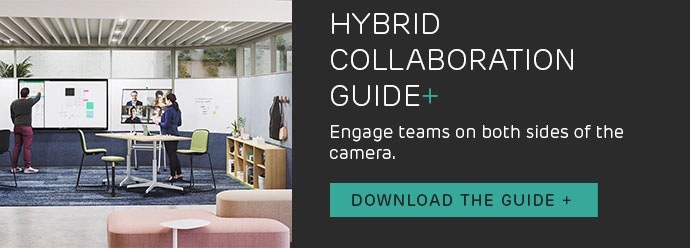There are many benefits of hybrid work. The biggest being the ability to attract and retain talent. Post pandemic, employers want more flexible ways of working and the ability to mix up their working week between home and the office.
But what are the downsides of hybrid work?
In a recent Steelcase webinar, 54% of 1,000 attendees said the biggest threat of hybrid work is cultural erosion.
The impact of hybrid work on culture: threat or opportunity?
“Hybrid work may be challenging initially, but there’s never been a greater opportunity for organisations to reset their culture.”
Some leaders argue you need everyone in the office to preserve company culture. While others are seeing this period of transition as an opportunity to remake culture, and are thinking about what this might look like in a hybrid world.
What we know for sure is that companies with healthy cultures have three times greater total returns to shareholders than companies without.
So how can you ensure the transition to a hybrid work model doesn’t come at a cost?
The office as a culture space
In a hybrid work model, the office becomes a culture space, providing workers with a social anchor. It becomes not just a place to do our work, but rather a place we can go to interact and collaborate with those we work with.
Designing the hybrid office must therefore be geared towards facilitating connections and helping people to feel part of a community. This means creating high-performing collaboration zones and informal social spaces where people can come together.
49% of UK workers want informal spaces to connect with colleagues
When people feel part of a community they can achieve more, are more productive, engaged, and innovative.
%20(1).jpg?width=800&name=My%20project%20(10)%20(1).jpg)
People need a place to call home at work
According to new Steelcase research:
“The most important driver for employee engagement, productivity and feeling connected to the culture is whether people like working from their office.”
While many organisations are shifting to hybrid work models to give workers more autonomy and control over their work-life balance, hybrid policies alone cannot address the sense of belonging that workers seek.
They need a space in the office where they can feel at home. Steelcase research revealed that 61% of UK workers want reservable workspaces.
Knowing they have a space to come together is what will encourage workers to come to the office and make them more likely to stay at a company.
Building a thriving community
“The hybrid workplace should be more like a thriving community where people feel belonging and purpose.”
Organisations should look to thriving communities as a model for the workplace. When the workplace is designed as a community, made of neighbourhoods, it helps people build a connection to the culture.
Neighbourhoods, much like the ones we live in, can be created within larger open spaces to give teams and departments a space to feel connected and at home.
These neighbourhoods include a variety of spaces that support a mix of uses and allow people to flow naturally from one activity to another. They consist of:
- Individual spaces assigned to one person or shared among the team
- Collaboration spaces for both in-person and virtual interactions that support the different ways people need to work together
- Places with privacy for individual focus work, finding solitude, or relaxation
- Informal areas to gather and socialise
Ultimately, neighbourhoods can help build a connection to the culture and sense of community, which helps encourage people to come to the office and make them more likely to stay at the company.
Flex Active Frames can help us build these neighbourhoods within larger spaces. Teams can create their own micro-spaces to support the working patterns that suit them best. With working areas defined and 'bounded', but not entirely enclosed, people can feel cocooned with their team, but also part of a wider whole.
%20(1).jpg?width=800&name=My%20project%20(8)%20(1).jpg)
Other products from the Flex Collection can help make these spaces more effective. Whiteboards, screens and other accessories can be rolled in and out as required. Height-adjustable desks can be pushed together for collaborative work or moved to a quiet nook for focus time.
Booths such as Campers&Dens can also provide a comfortable space equipped with all the tools and technology teams need to get work done, from seating and tabling to integrated screens and whiteboards.
%20(1).jpg?width=800&name=My%20project%20(9)%20(1).jpg)
Summary
The new hybrid work era is an opportunity to create a better working environment, and a better working culture, than ever. Reshaping your culture will be essential for creating new norms for how people will work together going forward.










